The exhilarating journey of a startup from its early stages to achieving hypergrowth brings multiplying challenges – the perpetual need for higher computing power with cost efficiency, the quest for high-performance speed, the demand for scalable and reliable infrastructure, and the imperative to focus on business initiatives rather than grappling with intricate infrastructure intricacies.
As your startup expands, infrastructure strains can hamper your ability to innovate rapidly. However, by migrating key operations to the cloud, specifically Amazon Web Services (AWS), startups have successfully powered their hypergrowth with:
- Slashed infrastructure costs by 66%,
- Accelerated time-to-market for new features by 43%,
- Increased staff productivity by 29%,
- Decreased security incidents by 45%.
The stats are clear – migrating your startup’s infrastructure to AWS can unlock transformational gains in cost, speed, productivity and security. This enables you to channel energy and resources to what matters most – building an exceptional product and delivering superior customer experiences.
In this blog post, we will explore key reasons and a strategic approach to migrate your high-growth startup to AWS. By migrating intelligently, you can rapidly scale your business to the next level while remaining lean, agile and hyper-focused on product innovation.
Reasons to migrate your startup to AWS
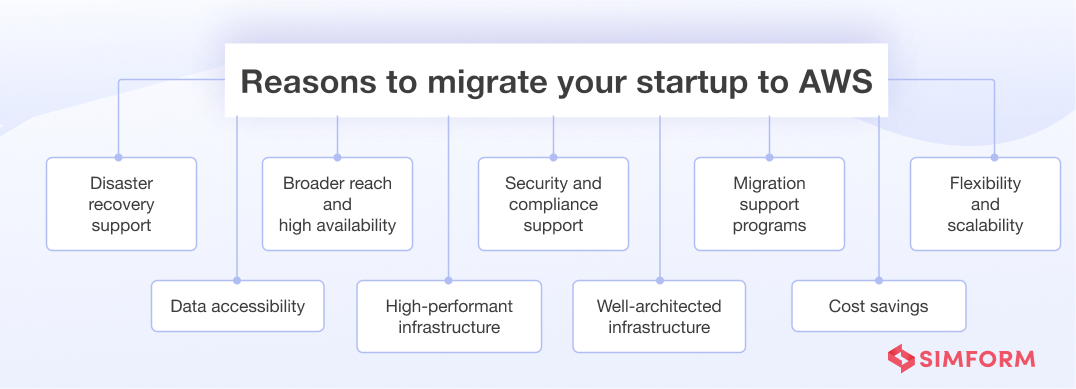
As the leading cloud provider for startups, AWS offers you deep expertise across 200 fully-featured services to help businesses scale. 83% of the unicorn startups and over 90% of the Cloud 100 rely on AWS, indicating its trusted operational excellence.
Since launching their startup program, AWS has also provided $6 billion in credits to 280K+ startups. With AWS, you get proven operational excellence in running cloud workloads, a pace of innovation by continuously expanding services, and lower TCO than on-premises infrastructure. Let’s delve into four compelling reasons why migrating your startup to AWS makes sense.
Cost savings
As an AWS startup, you get built-in cost optimization to stretch your budget. With pay-as-you-go pricing for over 200 services, you only pay for what you use without commitments. This flexibility helps control costs as you scale.
Partnering with a cloud consulting provider with AWS expertise, like Simform, can further optimize cloud spending. We focus on three key areas:
- Select optimal pricing models using tools like AWS Cost Explorer and Reserved Instances to reduce database, analytics, and compute costs.
- Match capacity to demand by identifying underutilized instances and resources to shut down when not needed. We leverage auto-scaling for savings.
- Implement processes to detect resource waste related to storage, networking, and balance workloads for maximum efficiency. Our team reviews usage regularly to delete idle and unnecessary infrastructure.
This expertise allows startups to get the most value from their cloud spending as they grow.
Broader reach and high availability
As your startup grows internationally, AWS enables deployment across 16 global regions with 42 availability zones for always-on application availability. For example, India’s largest online travel group, Ibibo, leveraged AWS’s worldwide footprint to reach over 3 million monthly users.
By running on AWS’s proven infrastructure, startups can easily reach global audiences and provide 24/7 application access without building data centers. However, global expansion brings complexity in ensuring high availability.
That’s where an AWS consulting expert like Simform can help you out. By architecting a robust, multi-region AWS environment, our developers put compute and data closest to your customers while building redundancy for always-on availability. You can lean on our AWS-certified team to ensure your infrastructure remains cutting-edge even as you rapidly scale.
High-performant infrastructure
Startups often worry about maintaining peak infrastructure performance when they move to growth and hyperscale stages. AWS provides on-demand access to enterprise-grade cloud infrastructure without large upfront investments to handle traffic spikes.
Also, with AWS auto-scaling groups, you can instantly increase servers to maintain high performance during viral growth moments. Lastly, leveraging AWS global infrastructure means low latency for customers worldwide. With AWS as the scalable backbone, you can focus resources on iterating and engaging customers, not maintaining servers.
Simform optimizes your AWS environment, granting on-demand access to enterprise-grade resources. We implement auto-scaling to effortlessly meet viral traffic and deploy servers near global customers for low latency. With our cloud proficiency optimizing your infrastructure, you can rapidly scale your vision without limitations.
Flexibility and scalability
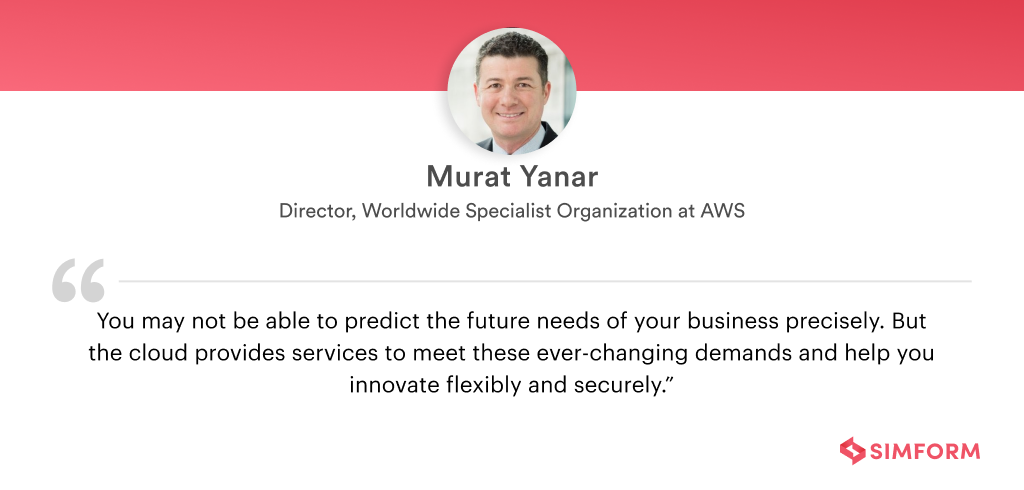
ENPICOM, a Dutch bioinformatics startup, provides data analysis solutions to decode the immune system and improve health outcomes. However, analyzing the massive genomic datasets proved costly with their on-prem infrastructure, IGX. By migrating to AWS, ENPICOM gained secure, scalable computing on EC2 to decode sequences faster. Within 6 weeks, their IGX platform was running on EC2 instances, ensuring computing power to match sporadic spikes in demand. By leveraging AWS auto-scaling groups, ENPICOM can scale capacity up or down based on needs, boosting performance over 3X.
The agility and elasticity provided by the AWS cloud were critical for ENPICOM to cost-effectively meet fluctuating demand. AWS empowers startups to instantly scale resources based on real-time workload changes, preventing overprovisioning. The on-demand availability of specialized infrastructure also gives startups the flexibility to experiment with innovative technologies like machine learning without upfront investments.
Simform works closely with startups on migration planning and building resilient, scalable architectures. Our expertise helps adapt on-premises applications to leverage auto-scaling, load balancing, containerization, and other AWS services. This enables truly elastic cloud-native systems that grow with your startup’s evolving needs.
While these benefits are compelling, they’re not easily achieved. Migrating startup applications to AWS requires thoughtful execution. Let’s walk through a step-by-step guide to ensure a smooth, disruption-free migration.
Steps to migrate your startup to AWS
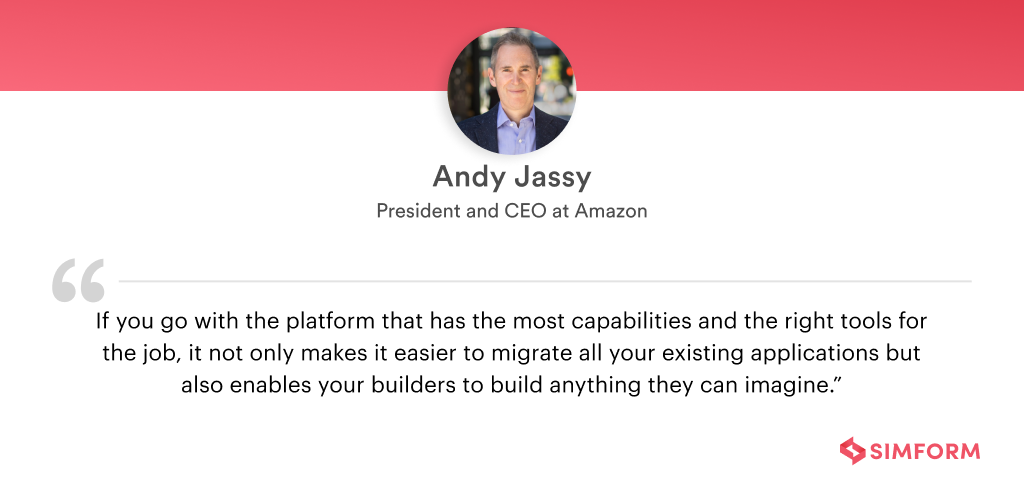
Migrations can hit startups with unexpected costs and app breakdowns. Some face skyrocketing AWS bills after modest proofs-of-concept, while others struggle with days of outages from overlooking needed re-architecture. Yet by following a careful migration blueprint at each step, startups can tap the cloud’s full potential without the pitfalls.
This guide details the planning and execution to not just migrate successfully once but also enhance innovation capabilities for the long term. The result: no unexpected roadblocks, just product acceleration matched with startup agility.
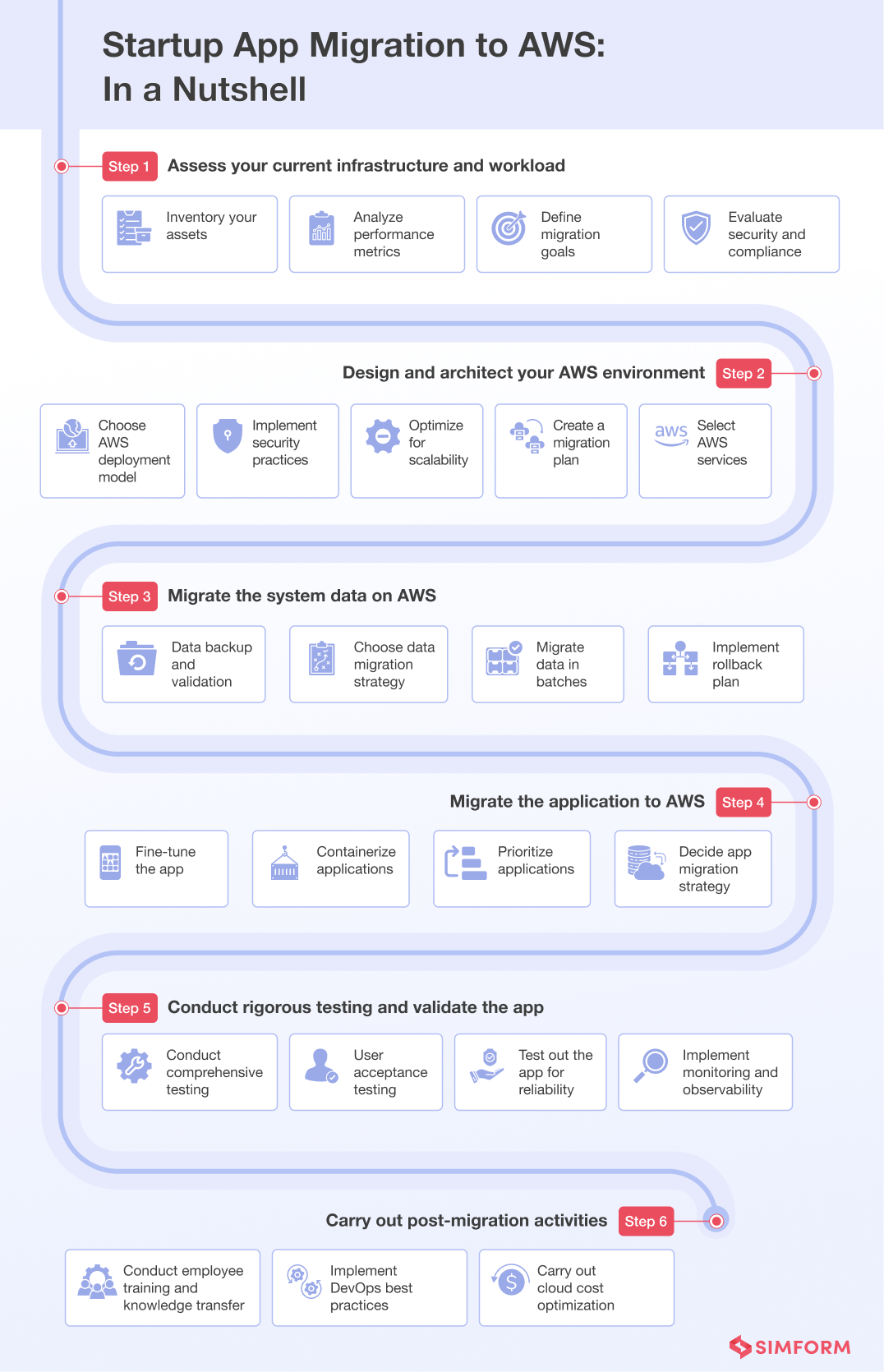
Step 1: Assess your current infrastructure and workload
Assess current infrastructure and workloads to fully understand your existing technology architecture, applications, usage patterns, costs, performance, and security requirements. This assessment provides the foundation to map the current environment to the optimal AWS services and infrastructure that will support migration.
Inventory your assets
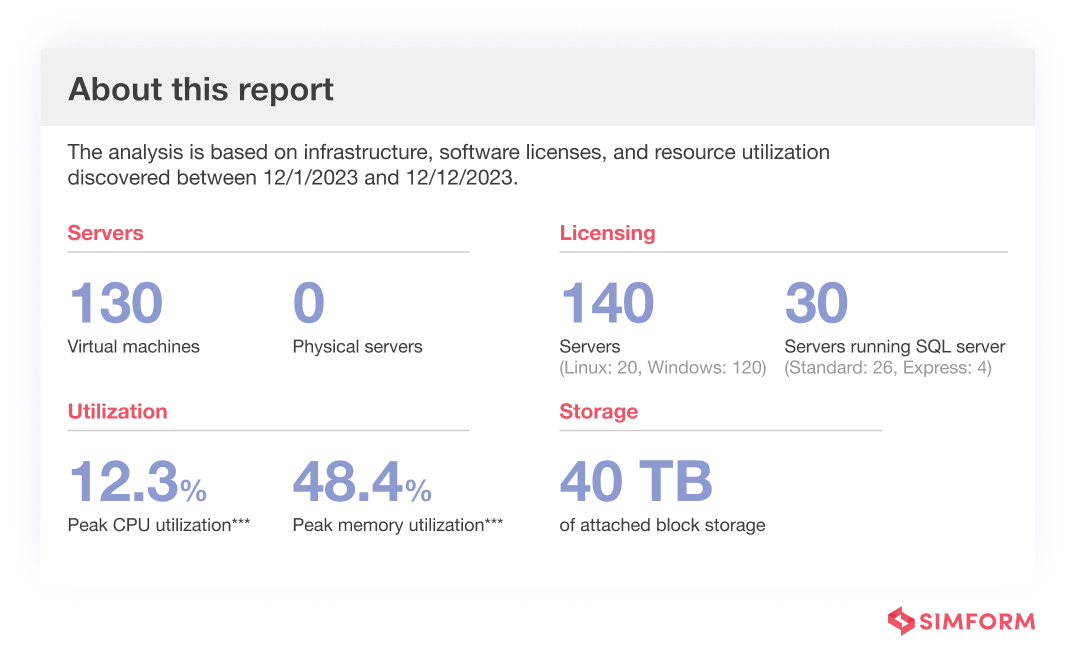
Start by creating a comprehensive inventory of your assets, including hardware, software, and data. It involves identifying servers, databases, applications, and other components essential to your business operations. Consider the dependencies and relationships between these assets.
Key concerns at this stage are potential disruptions from downtime or data loss during eventual migration. AWS Migration Evaluator rapidly scans your on-premise infrastructure to accurately assess your current state. By reporting on aspects like server configurations, virtual machine usage patterns, and database workloads, it creates visibility before transition. AWS can then use these insights to recommend optimally sized cloud services to run existing workloads while architecting for future scale.
With database and server replication fully managed by AWS migration tools, asset inventory gives clear visibility to plan the switchover confidently while protecting uptime and data integrity.
Analyze performance metrics
Assess metrics like CPU, memory, and network usage to understand normal operational ranges and peak capacities. Also, measure overall efficiency via metrics such as application response times, database transaction volumes, server load, etc. This quantifies the performance levels your systems deliver today.
We understand that maintaining (if not improving) application performance post cloud migration is a top priority for startups. AWS offers purpose-built tools to enable just that.
Amazon CloudWatch allows not only monitoring resource utilization in real-time but also setting automatic alerts if thresholds are crossed. Additionally, AWS Trusted Advisor analyzes cloud infrastructure deployments and configures them for peak optimization. It provides tailored recommendations on performance improvements, cost savings, fault tolerance, and service limit tracking.
We saw this first-hand when working with an AI infrastructure startup to migrate to AWS. The client wanted to migrate their resources from on-premise to AWS. During migration, we had to ensure optimum resource utilization, which became possible with CloudWatch alarms that monitored metrics such as CPU utilization, memory usage, and network traffic for our AWS resources. It helped us maintain system efficiency during migration.
Define migration goals
Defining clear, measurable migration goals is crucial to ensure consensus on intended outcomes upfront when moving to AWS. Typical goals for startups revolve around leveraging cloud agility to accelerate product innovation and time-to-market, driving infrastructure cost efficiencies, and maintaining or enhancing application reliability and security. Quantitative goals across metrics like release velocity, cost savings, uptime targets, and compliance standards facilitate accountable execution.
AWS provides resources like the AWS Migration and Modernization Center to assist in goal definition and offers various services such as AWS Cost Explorer for cost management, ensuring that migration aligns with business objectives.
Evaluate security and compliance
Don’t overlook security and compliance in the cloud migration rush. The cloud creates new exposure points: data and apps will travel through networks to AWS under complex permissions. Without proactive measures, you risk breaches or regulatory fines that jeopardize migration.
Step 2: Design and architect your AWS environment
The migration to AWS presents a valuable opportunity for a startup to design for scale and performance from the beginning. Rather than just lifting and shifting your infrastructure, thoughtfully architecting your environment on AWS allows you to build with flexibility and efficiency in mind. A well-architected environment minimizes risks, enhances performance, and sets the stage for a seamless transition, ultimately contributing to the overall success of your AWS migration.
Choose an appropriate AWS deployment model
As a startup looking for agility and cost-efficiency, a cloud-native deployment model on AWS is the best approach. This fully utilizes on-demand resources that automatically scale to meet needs. Services like EC2, Lambda, and S3 align to the benefits of cloud-native – flexible compute, serverless functions, and storage.
However, existing on-premises systems may mean adopting a hybrid model during initial migration. This blends existing infrastructure with new AWS components gradually over time. The hybrid model allows migrating application segments independently while maintaining legacy systems where needed.
When choosing deployment models, consider workload patterns in depth:
- Spiky or variable traffic suits serverless computing via Lambda
- Steady, production workloads align to dedicated EC2 instances
- Storage needs may leverage S3 flexibility or more purpose-built databases
Testing different services during the migration phase is key to optimizing the choice of deployment model per use case. Monitoring resource utilization over time gives data to right-size infrastructure choices in the long run.
Select AWS services
To kick off the design process, choose AWS services that align with your specific requirements. AWS offers services catering to diverse needs like computing, storage, databases, analytics, etc. Selecting services like Amazon EC2 for scalable compute capacity, Amazon S3 for durable and scalable object storage, and Amazon RDS for managed relational databases can form the core of your architecture.
The challenge here is balancing functionality with cost-effectiveness. So, you need to think about optimizing resource utilization and minimizing expenses. AWS Cost Explorer can be a valuable tool for estimating costs and ensuring that the chosen services fit within budget.
Create a migration plan
A meticulous migration plan minimizes downtime and ensures a smooth transition. Define a step-by-step approach, considering data migration, application dependencies, and user impact. AWS Migration Hub facilitates tracking the progress of your migration, providing a centralized view of all application migrations.
At this point, the common worry is about disruptions to business operations during migration. A well-structured migration plan and AWS Server Migration Service for replicating on-premises servers to the cloud helps mitigate these concerns.
Implement security best practices
AWS offers robust tools to safeguard your infrastructure. Leverage AWS Identity and Access Management (IAM) for fine-grained control over user permissions and AWS Key Management Service (KMS) for encrypting sensitive data.
You can also use AWS WAF (Web Application Firewall) to protect web applications. Simform’s developers help enhance web app security, improve compliance, block malicious traffic, and safeguard sensitive data using AWS WAF configurations tailored to your application needs.
Optimize for scalability
You often need help scaling your business seamlessly with growing user demand. Use services like AWS Auto Scaling to adjust capacity dynamically based on demand. Consider serverless architectures with AWS Lambda for event-driven computing, enabling efficient resource utilization.
Lastly, use AWS Elastic Load Balancing to distribute incoming traffic across multiple instances, ensuring high availability and fault tolerance. The ability to scale resources up or down on demand provides reassurance in adapting to fluctuating workloads.
Step 3: Migrate the system data on AWS
Here, you must focus on seamlessly transferring your existing system data to the AWS cloud infrastructure. A meticulous approach is essential to ensure data integrity, minimize downtime, and optimize performance.
Data backup and validation
Begin by safeguarding your data through a comprehensive backup process. This step involves creating copies of all critical data, verifying their accuracy, and validating their completeness. AWS offers various services to facilitate this, such as Amazon S3 for scalable object storage and AWS Backup for centralized backup management.
There are concerns about data loss or corruption during this step. Meticulous validation procedures should ensure that the backup is consistent and reliable. AWS provides tools like AWS DataSync for efficient, automated data transfer and AWS Snowball for large-scale data migration.
Simform recently collaborated with a startup providing schools with data solutions for communication and management. The client had been using another cloud provider and wanted to leverage AWS for improved availability and performance. The main challenge was transferring large data amounts while ensuring consistency and integrity. We used Amazon S3 to store and retrieve data for front and backend applications, securing 99.9% data integrity and uptime during migration. S3 prevented data loss and ensured high availability.
Choose the right data migration method
AWS supports various data migration methods, including online migration for minimal downtime and offline migration for large volumes of data.
AWS Database Migration Service (DMS) is a valuable tool that supports homogeneous and heterogeneous migrations, addressing concerns about compatibility during the migration process. Meanwhile, AWS Server Migration Service (SMS) can simplify the process by automating server migrations, reducing the risk of errors and downtime.
One of our clients, an eCommerce analytics startup, migrated to AWS because of scalability, availability, integration, and security challenges on DigitalOcean. Our developers employed DMS to transfer large data volumes from PostgreSQL to RDS, ensuring high availability, flexibility, and scalability during the migration. DMS simplified the complex transition to AWS, enabling them to leverage AWS’s performance, reliability, and security while minimizing disruption.
Migrate data in batches
To prevent overwhelming the system and ensure continuous operation, we recommend migrating data in manageable batches. AWS provides tools like AWS Data Pipeline for orchestrating and automating the movement and transformation of data between different AWS services.
It’s natural to worry about the impact on system performance during data migration. Migrating in batches allows for a controlled process, minimizing the risk of disruptions and enabling the team to address any unforeseen issues promptly.
Implement a rollback plan
Despite careful planning, unforeseen challenges may arise during migration. A well-defined rollback plan using AWS services mitigates these concerns, offering a safety net in case issues arise and allowing for a swift return to the previous system configuration. AWS services like AWS CloudFormation can automate the rollback process.
Step 4: Migrate the application to AWS
Once the groundwork is laid through careful planning and architecture, the next critical step is executing the actual migration of applications to the AWS cloud. This phase shifts the startup into full AWS adoption through systematic and prioritized app migrations, aiming to achieve business continuity and optimized platforms ready to leverage cloud capabilities longer-term.
Decide the application migration strategy
To begin, you must strategically choose an approach for migrating your application. The 6R framework offers various strategies: Rehost (lift and shift), Replatform (lift, tinker, and shift), Refactor/Re-architect (rebuild), Repurchase (replace with a commercial product), Retire (eliminate), and Retain (keep as is). Each approach has its merits and challenges, and the optimal choice depends on factors like budget, timeline, and the desired level of transformation.
For a Rehost strategy, AWS services like AWS Server Migration Service (SMS) simplify migration by automating the lift-and-shift of on-premises servers to AWS. If you opt for a Refactor/Re-architect approach, AWS provides tools like AWS Elastic Beanstalk and AWS Lambda for rebuilding applications to leverage cloud-native architecture.
Prioritize applications
Begin by auditing all applications and their interdependencies. Seek to migrate standalone systems first for quicker wins. Identify high-value, high-impact applications next to maximize business benefits. Avoid tackling complex, interconnected systems too early before foundational infrastructure is in place.
AWS Migration Hub provides a centralized view, allowing you to track and manage migrations across multiple services. You can leverage its real-time insights to prioritize applications based on their readiness and dependencies. It empowers you to make informed decisions, optimize resource allocation, and streamline migration.
Containerize the applications
Containerization allows packaging applications and their dependencies into a standardized unit for easy deployment. It benefits startup applications by simplifying deployment, accelerating scalability, and ensuring consistent performance across diverse environments, fostering agility, reliability, and efficient resource utilization.
Here, the challenge is related to potential compatibility issues and the complexity of containerization. AWS offers Amazon Elastic Container Service (ECS) and Amazon Elastic Kubernetes Service (EKS) to simplify the orchestration and management of containerized applications.
Fine-tune the app for performance
There’s always concern about achieving the desired performance levels and meeting user expectations, making ongoing monitoring and optimization crucial. AWS provides services like Amazon CloudWatch for monitoring, AWS Auto Scaling for dynamic scaling, and AWS Elastic Load Balancing for distributing traffic.
Step 5: Conduct rigorous testing and validate the app
During application migration, performing a compatibility test focuses specifically on ensuring seamless functionality of the migrated app within the new environment. It emphasizes confirming that the app works optimally with the updated infrastructure, configurations, and dependencies.
Conduct comprehensive testing
Comprehensive testing involves a battery of tests covering various scenarios to identify and rectify any issues before the migration. It includes unit testing, integration testing, regression testing, and performance testing.
Ensuring the app’s integrity and functionality is paramount to retaining user trust and satisfaction during and after migration to AWS. AWS services like AWS CodeBuild, AWS CodePipeline, and AWS CodeDeploy aid in automating and streamlining the testing process, allowing for rapid iterations and bug fixes.
Carry out user acceptance testing
User acceptance testing (UAT) involves real users testing the application to ensure it meets their requirements and expectations. There are massive concerns about delivering a seamless user experience post-migration.
AWS services like AWS Device Farm and AWS Amplify Console facilitate UAT by providing tools for automated testing across various devices and environments, ensuring the app functions flawlessly for end-users.
Test out the app for reliability and fault tolerance
App resiliency is important, not just so the app can recover from any failure but also so that the app recovers within the desired timeframe.
AWS offers services like AWS CloudWatch for monitoring and AWS Auto Scaling for ensuring fault tolerance and high availability. Testing the app’s response to simulated failures and load testing using AWS CloudWatch metrics ensures its reliability and fault tolerance.
Implement monitoring and observability tools to track performance
Monitoring and observability are critical for ongoing performance assessment. AWS services like AWS CloudTrail, AWS X-Ray, and AWS CloudWatch provide monitoring, tracing, and logging capabilities. You can focus on implementing these tools to track performance metrics, identify bottlenecks, and optimize app performance continuously.
Step 6: Carry out post-migration activities
This phase ensures a seamless transition by addressing residual issues, optimizing performance, and confirming that all systems operate at peak efficiency in the new environment. By proactively resolving post-migration challenges, you fortify the foundation for sustained operational excellence, enhancing user satisfaction and maximizing the return on investment.
Carry out cloud cost optimization
In this phase, focus on refining your AWS resource usage to maximize efficiency and minimize unnecessary expenses. Utilize AWS Cost Explorer to gain insights into your spending patterns and identify areas for optimization.
If you’re a startup, you’re always on a tighter budget, and that’s why cloud cost optimization becomes much more important for your business. Employ services like AWS Lambda for serverless computing to pay only for the computing time consumed and leverage Amazon EC2 Spot Instances for cost-effective, scalable computing capacity.
Implement DevOps best practices
Efficiently integrate development and operations by implementing DevOps best practices. Use AWS CodePipeline for automated continuous integration and delivery (CI/CD) pipelines, enabling seamless code deployment. Employ AWS CloudFormation for infrastructure as code (IaC), allowing you to provision and manage AWS resources through templates.
You’re always looking to achieve faster release cycles and maintain a stable and reliable application environment to get ahead of your competitors and avail of first-movers advantage, if possible. By embracing DevOps on AWS, you address these concerns and enhance collaboration between development and operations teams.
Conduct employee training and knowledge transfer
Invest in your team’s skills by providing comprehensive training on AWS services and best practices. AWS Training and Certification offers courses tailored to different roles and skill levels.
Getting used to AWS and the cloud environment is a bit of a learning curve for any new team. Ensuring proper training and knowledge transfer empowers your team to operate and innovate within the AWS ecosystem effectively.
Why choose Simform to migrate your startup to AWS?
Simform is a leading cloud migration provider with validated expertise in helping startups transition successfully to AWS. Our deep technical capabilities, advanced certifications, and proven success in delivering secure, optimized AWS environments position us as a trusted migration partner.
Here are some key reasons to choose Simform:
- AWS-certified experts: Our team includes 200+ AWS-certified solutions architects and consultants with years of experience migrating startups.
- Financial incentives: We help startups unlock AWS promotional credits and funding programs like MAP (Migration Acceleration Program), making migrations more cost-effective and scalable from the start.
- Tailored strategies: Our experts craft customized AWS migration roadmaps aligned to your specific business goals and constraints.
- Enhanced security: Our security experts enforce strict IAM, encryption, network security, DDoS protection, and observability to create a robust security posture before, during, and after migration.
- Post-migration support: We provide personalized assistance, including 24/7 monitoring, performance optimizations, issue resolution, security audits, and staff training.
Want to leverage these migration benefits and expertise? Contact our subject-matter experts for a free 30-minute consultation to kickstart your seamless AWS migration journey.